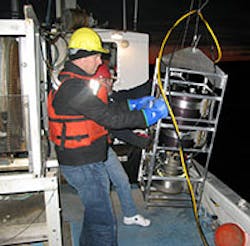Vision system celebrates six weeks underwater
An imaging particle analysis system from marine instrumentation manufacturer Fluid Imaging Technologies (Yarmouth , ME, USA) recently surpassed six weeks of continuous, unattended operation during in-situ deployment in the coastal waters of Florida.
Featuring patent-pending, chemical-free, biofouling control technology from Battelle (Columbus, OH, USA), the Submersible FlowCAM automatically detects waterborne particles and microscopic organisms, acquires high-resolution digital images of each one detected and counts, measures, and characterizes them using a choice of 32 different properties such as size, shape, and fluorescence.
During the six-week, remote deployment, the Submersible FlowCAM acquired and measured thousands of images sampled at a variety of depths from its mooring.
The data was accessed online in real time from the company’s Yarmouth, Maine test laboratory and saved for further analysis while the FlowCAM’s built-in, proprietary pattern recognition software automatically differentiated, identified, and quantified each individual microorganism and particle. On-the-fly adjustments to the flow rate, camera speed, sampling schedule protocols, and other parameters could also be made remotely.
The Submersible FlowCAM includes the same patented FlowCAM imaging technology proven effective by the US Naval Research Labs, Scripps Institution of Oceanography, the National Institute of Oceanography (Goa, India), and hundreds of other installations worldwide.
The Submersible FlowCAM operates in freshwater, ocean water, and estuarine environments and may be configured to be deployed aboard autonomous underwater vehicles (AUVs) and tethered behind research vessels and sampling boats in addition to being moored.
-- by Dave Wilson, Senior Editor, Vision Systems Design
